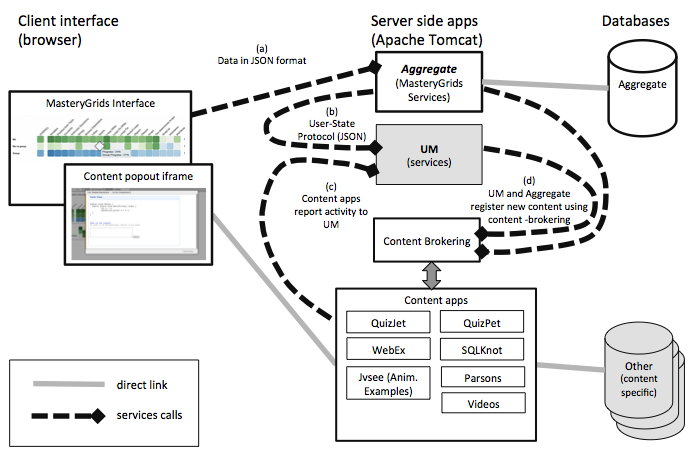Difference between revisions of "Aggregate"
From PAWS Lab
| (3 intermediate revisions by one other user not shown) | |||
| Line 1: | Line 1: | ||
| + | [[Image:arch_v2.png|Aggregate Architecture]] | ||
| + | |||
We developed an adaptive social learning architecture Aggregate to support [[Mastery Grids Interface]]. We design this architecture to integrate content from diverse sources. The explanation of the procedures and links to associated resources are given below. | We developed an adaptive social learning architecture Aggregate to support [[Mastery Grids Interface]]. We design this architecture to integrate content from diverse sources. The explanation of the procedures and links to associated resources are given below. | ||
| Line 6: | Line 8: | ||
* The figure shows several different Content apps (QuizJet, QuizPet, Webex, etc.). Each of these applications are integrated in 2 ways: | * The figure shows several different Content apps (QuizJet, QuizPet, Webex, etc.). Each of these applications are integrated in 2 ways: | ||
| − | ** The content application needs to log information of the learner activity within the content to the User Model (letter c in the diagram). Currently | + | ** The content application needs to log information of the learner activity within the content to the User Model (letter c in the diagram). Currently, the content applications are using our ADAPT2 [[CUMULATE protocol]]. |
| − | ** The content application provides a service to list all the available content. This service implement the [https://github.com/PAWSLabUniversityOfPittsburgh/mastery-grids/blob/master/documentation/Content_Brokering_API_2016_01_21.pdf content brokering specification], which defines a JSON-format protocol to allow external applications to discover content. | + | ** The content application provides a service to list all the available content. This service implement the [https://github.com/PAWSLabUniversityOfPittsburgh/mastery-grids/blob/master/documentation/Content_Brokering_API_2016_01_21.pdf content brokering specification], which defines a JSON-format protocol to allow external applications to discover content. Both Aggregate and the User Model use the content brokering to register new content. |
| + | Several content application and their respective content brokering are implemented in [http://acos.cs.hut.fi/ ACOS server]. | ||
| − | |||
| − | + | == Associated resources == | |
| − | * | + | * [https://github.com/PAWSLabUniversityOfPittsburgh/mastery-grids Mastery Grids repository] (contains aggregate, mastery grids interface, documentation and course authoring tool) |
| + | * [https://github.com/PAWSLabUniversityOfPittsburgh/AggregateUMServices User State Services repository] | ||
| + | * [[CUMULATE|user modeling specification]] | ||
| − | + | == Content application resources == | |
| − | * | + | * [[Smart Content|Smart content]] : provides an explanation of content applications |
| − | + | * [http://acos.cs.hut.fi ACOS server] : provides details of ACOS infrastructure, content and protocols | |
| − | + | * [https://github.com/PAWSLabUniversityOfPittsburgh/quizjet QuizJet repository] | |
| − | + | * [https://github.com/PAWSLabUniversityOfPittsburgh/quizpet QuizPet repository] | |
| − | [[ | + | * [https://github.com/PAWSLabUniversityOfPittsburgh/annotated-examples Annotated Examples (Webex) repository] |
| + | * [https://github.com/PAWSLabUniversityOfPittsburgh/educational-videos Educational Videos repository] | ||
Latest revision as of 03:38, 5 April 2016
We developed an adaptive social learning architecture Aggregate to support Mastery Grids Interface. We design this architecture to integrate content from diverse sources. The explanation of the procedures and links to associated resources are given below.
- Mastery Grids Interface receives all the information to display (this is course structure, links to content and progress levels of the learner and the group of learners) from services hosted in Aggregate (a in the diagram). This information is passed in JSON format.
- To let Mastery Grids know the level of progress of the learners in the topics and the content, Aggregates call services from a User Model (UM in the figure). See point b) in the figure. These services are documented in User State Protocol
- The figure shows several different Content apps (QuizJet, QuizPet, Webex, etc.). Each of these applications are integrated in 2 ways:
- The content application needs to log information of the learner activity within the content to the User Model (letter c in the diagram). Currently, the content applications are using our ADAPT2 CUMULATE protocol.
- The content application provides a service to list all the available content. This service implement the content brokering specification, which defines a JSON-format protocol to allow external applications to discover content. Both Aggregate and the User Model use the content brokering to register new content.
Several content application and their respective content brokering are implemented in ACOS server.
Associated resources
- Mastery Grids repository (contains aggregate, mastery grids interface, documentation and course authoring tool)
- User State Services repository
- user modeling specification
Content application resources
- Smart content : provides an explanation of content applications
- ACOS server : provides details of ACOS infrastructure, content and protocols
- QuizJet repository
- QuizPet repository
- Annotated Examples (Webex) repository
- Educational Videos repository

